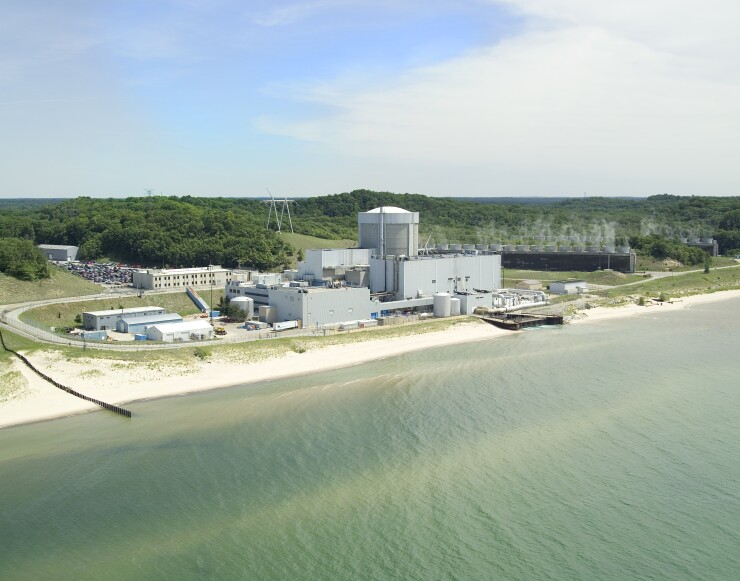Biden’s $1.5 billion loan backs nation’s first nuclear restart at Michigan plant
4 min read

The Biden administration is expected to announce a $1.5 billion federal loan to repower a shuttered Michigan nuclear plant, marking a first for the U.S. as the administration’s seeks to move the country toward 100% carbon-free power in the coming decades.
The Palisades power plant in southwest Michigan, owned now by Holtec International, was decommissioned in May 2022 by its former owner after being in service for 50 years. Bloomberg and Reuters
Nick Culp, Holtec’s senior manager of government affairs for Palisades, said the company feels “very optimistic about the loan process” and “confident about the strength of our application.”
Holtec International
“We’re targeting, pending loan approval, to restart the existing site by the end of 2025,” Culp said.
Michigan Democrat Gov. Gretchen Whitmer supports the reopening, and the state has allocated $150 million to the initiative, contingent on the federal loan. The plant would help Michigan reach its
“We are showing the world that Michigan will be an epicenter of clean energy production and do what it takes to save jobs, protect local communities, and deliver reliable power to homes and small businesses,” said Whitmer press secretary Stacey LaRouche in an email.
On the federal level, a bipartisan group of House representatives led by Republican Michigan Rep. Bill Huizenga wrote a
Holtec separately has proposed the construction of two small modular reactors at the Palisades site, a new nuclear technology that advocates say represents a lower-cost alternative to traditional reactors. The small reactors would each total 300 megawatts of power, adding a total of 600 megawatts to the existing plant’s 800 megawatts. The company
The SMR technology remains untested in the U.S., with the Utah Associated Municipal Power Systems in November announcing
Nuclear power remains controversial among some environmental critics and faces massive capital costs, but appears poised for a rebound under the Biden administration’s goal of reaching 100% clean energy electricity by 2035 and net-zero emissions by 2050.
The 2022 Inflation Reduction Act provides $30 billion in production tax credits to existing nuclear power plants from 2024 through 2032. The tax credits are designed to preserve existing nuclear infrastructure and are on top of $6 billion in the 2021 Infrastructure Investment and Jobs Act’s Civil Nuclear Credit Program, for nuclear units that might otherwise be set to retire.
Utilities and other owners have floated billions of municipal bonds to build nuclear facilities, but it’s difficult to determine how much nuclear-related muni debt is outstanding, as utilities often don’t break down their borrowings by project.
The DOE will consider Holtec’s financing plan, which includes debt service, as part of its review process for the Palisades repowering, said Culp, who declined to put a price tag on the project. Funding would come from a mix of federal and state support and Holtec’s contribution, he said.
A long-term power purchase agreement that was hammered out last year is key to the project, said Fitch Ratings analyst Dennis Pidherny. The long-term power purchase agreement calls for Michigan-based Wolverine Power Cooperative and its non-profit rural electric cooperative project partner, Hoosier Energy, to purchase all of power from the 800-megawatt plant.
“It’s not surprising that the governor of Michigan is a big supporter of this restart,” Pidherny said. “They wanted most of the energy and benefits to stay in the state of Michigan, which is why it was a natural for Wolverine to step forward and look at this as a part of their own effort to address transition to lower carbon.”
In a November report titled “New Nuclear Projects Remain a Challenge for Public Power,” Fitch predicted that most U.S. public power systems would be unlikely to pursue new nuclear construction over the next few years in light of persistent cost challenges and risks. Fitch noted that in Georgia, the latest Vogtle unit is finally expected to come online this year but construction of the two newest units was “seven years late and $16 billion over budget.”
In what remains one of the largest municipal bond defaults to date, the Washington Public Power Supply System in the early 1980s
But Holtec’s plan for a restart is lower risk than build-from-scratch projects, Pidherny said. “We think it’s a project that makes sense,” he said, adding it remains to be seen how Holtec manages the thorny regulatory and technical process. “The nuclear sector is one that you need size and breadth and resources to make significant headway in the sector just given the size and cost of these plants and the risks,” he said. “It is a valid question whether or not they will be able to coordinate all the pieces that have to be coordinated here.”
The U.S. has 93 operating commercial nuclear reactors at 55 nuclear power plants located in 28 states, according to the Energy Information Administration. The average plant age is almost 40 years. Most reactors are located east of the Mississippi, and Illinois has the most, with 11 reactors at six plants, according to the EIA.
Nuclear power accounts for about 20% of total U.S. electricity generation, though generation has declined slightly over the last few years, and more than 50% of clean electricity. Six units have retired since 2017 and three more were on track to retire, but at least two of those, in California, recently won extensions.







